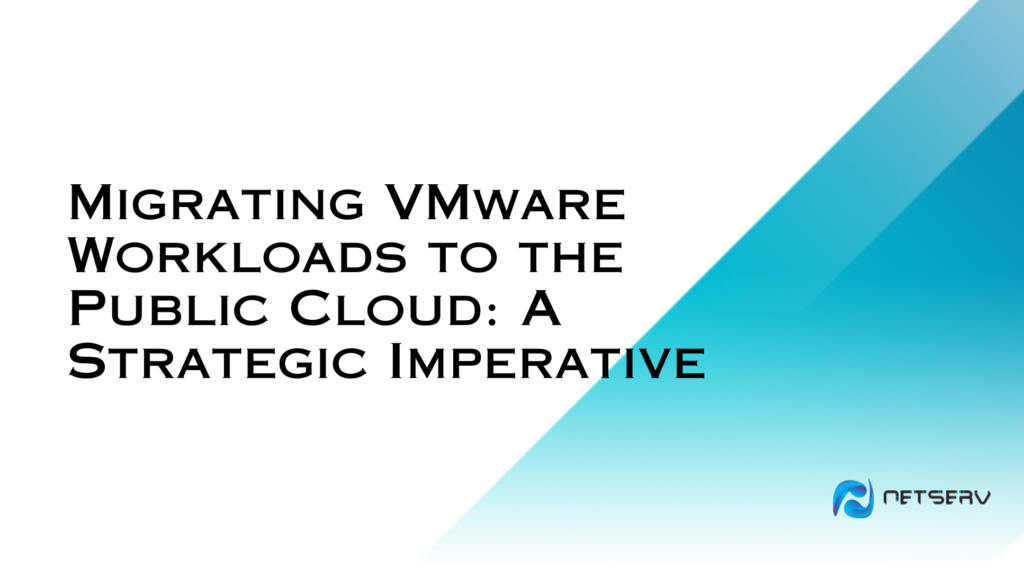
Migrating VMware Workloads to the Public Cloud: A Strategic Imperative
In today’s rapidly evolving digital landscape, more and more organizations are recognizing the advantages of moving their VMware-based on-premises workloads to the public cloud. This strategic move presents a compelling proposition to unlock agility, scalability, and cost optimization while capitalizing on the familiarity and compatibility of existing VMware investments.
Benefits of Migrating to Public Cloud
Scalability and Elasticity: By providing on-demand access to virtually limitless computing resources, public clouds enable organizations to scale their infrastructure up or down to align with dynamic business demands. This elasticity eliminates the need for over-provisioning resources, ensuring optimal resource utilization and cost efficiency.
Cost Optimization: Implementation a consumption-based pricing model can potentially reduce capital expenditures and shift to an operational expense model. Public cloud providers offer pay-as-you-go pricing, enabling organizations to pay only for the resources they consume, resulting in significant cost savings.
Robust Disaster Recovery and Business Continuity: Public cloud providers offer strong disaster recovery and business continuity solutions, safeguarding data and minimizing downtime in the event of disruptions. Organizations can leverage geographically distributed data centers, automated backup and replication mechanisms, and failover capabilities to enhance resilience and mitigate risk.
Access to Advanced Services: Public clouds provide access to a wide range of advanced services, such as artificial intelligence, machine learning, big data analytics, and serverless computing. Leveraging these services can help organizations accelerate innovation, gain valuable insights, and unlock new business opportunities.
Enhanced Security and Compliance: Public cloud providers offer industry-leading security practices, tough access controls, and comprehensive compliance certifications. Organizations can benefit from the cloud provider’s expertise and investments in security, freeing up internal resources and ensuring adherence to regulatory requirements.
A Phased Approach to Migration
Assessment and Discovery: A comprehensive assessment of the existing VMware environment, including workloads, dependencies, performance requirements, and security considerations, is necessary. Organizations must identify workloads suitable for migration, prioritize based on business criticality and technical complexity, and evaluate application compatibility, licensing implications, and potential refactoring needs.
Planning and Design: Defining the migration strategy, considering factors such as lift-and-shift, rehost-and-optimize, or refactor-and-modernize approaches, is vital. Designing the target cloud architecture, ensuring alignment with organizational requirements, security policies, and compliance standards, is essential. Developing a detailed migration plan, including timelines, resource allocation, and risk mitigation strategies, is crucial.
Proof of Concept and Validation: Conducting a proof of concept (PoC) or pilot migration to validate the migration strategy, identify potential issues, and refine the approach is imperative. Testing application functionality, performance, and compatibility in the target cloud environment is essential. Validating security configurations, access controls, and compliance requirements is a must.
Migration Execution: Executing the migration plan, following established processes and best practices, is essential. Leveraging automation tools and scripts to streamline the migration process and minimize potential errors is critical. Implementing data migration and synchronization strategies, ensuring data integrity and consistency, is necessary.
Cutover and Validation: Performing a controlled cutover, transitioning workloads from the on-premises environment to the public cloud, is vital. Conducting thorough testing and validation, including user acceptance testing and performance monitoring, is essential. Ensuring seamless integration with existing systems and applications is a must.
Optimization and Continuous Improvement: Monitoring and optimizing the migrated workloads, leveraging cloud-native services and automation capabilities, is crucial. Implementing continuous improvement processes, including performance tuning, cost optimization, and security enhancements, is essential. Establishing ongoing governance and monitoring practices to maintain operational excellence is necessary.
Migrating VMware workloads from on-premises to the public cloud is a strategic move that can enhance agility, scalability, and cost optimization while leveraging the familiarity and compatibility of existing VMware investments. By carefully assessing requirements, planning the migration strategy, and executing a phased approach, organizations can unlock the full potential of the public cloud, accelerate innovation, and drive digital transformation. With the right planning and execution, organizations can seamlessly transition to the public cloud and position themselves for long-term success in today’s rapidly evolving digital landscape.
Feel free to contact us here or email us at info@ngnetserv.com for further information. Additionally, you can schedule a call with us using our calendar here to learn more about the services we offer.
